#esa mars express
Text

Mars, as seen by ESA's Mars Express satellite
#go for queue deploy#esa#european space agency#mars#solar system#planet#satellite#space#outer space#space exploration#spaceflight#science#space and astronomy#astronomy#space photography#technology#engineering#stem#exploration#mars express#mars exploration#esa mars express
1K notes
·
View notes
Text
Terra Sabaea and Arabia Terra – ESA Mars Express

One of my all-time favourite images of Mars is this enhanced colour image captured by ESA's Mars Express orbiter on 17 June 2019. It shows a beautiful slice of the Red Planet stretching from the north polar cap to the northern rim of Hellas Planitia, highlighting the crater surface of Terra Sabaea and Arabia Terra. The original image has a resolution of about 1 km/pixel.
To the north, two craters stand out to me: Lyot (a complex crater in Vastitas Borealis) and Moreux (a smaller but visually darker crater in a geologically complex region of Arabia Terra). Near the centre of frame are a pair of large but shallow craters: Cassini and Tikhonravov. To the south lies Huygens, the largest crater on Mars with a well defined rim.
About the mission
Mars Express was launched from the Baikonur Cosmodrome on 2 June 2003 and entered into orbit around Mars in record time on 25 December 2003. It's the second longest lasting Mars orbiter in history after NASA's 2001 Mars Odyssey orbiter.
Due to its flexibility and importance in the study of Mars, the mission has been repeatedly extended to as far out as 2026, with a further provisional extension to 2028 likely. It's hard to believe that this was the same orbiter that deployed the failed Beagle 2 lander to the Martian surface almost 20 years ago.

14 notes
·
View notes
Video
Perspective view of Mars’s Tharsis volcanoes by European Space Agency
Via Flickr:
This oblique perspective view shows a slice of Mars imaged to mark a milestone for ESA’s Mars Express: its 25 000th orbit around the Red Planet. It was generated from a digital terrain model and the nadir (downward-pointing) and colour channels of Mars Express’s High Resolution Stereo Camera. The vertical scale is exaggerated by a factor of approximately three, making the volcanoes look three times higher than they are in real life. Three of Mars’s famously colossal volcanoes are shown here: from left to right, Arsia, Pavonis and Ascraeus Mons. The mound of Mars’s largest volcano, Olympus Mons, can be spied further away at the top of the frame, while the fractured terrain of Noctis Labyrinthus, Mars’s ‘labyrinth of night’, can be seen in the foreground. Read more [Image description: This image shows a tan-coloured portion of Mars, with the curvature of the planet visible to the top left the frame. Four of Mars’s volcanoes can be seen in relief against the dark background, shown as darker mounds stretching away from the viewer.] Credits: ESA/DLR/FU Berlin, CC BY-SA 3.0 IGO
#ESA#European Space Agency#Space#Universe#Cosmos#Space Science#Science#Space Technology#Tech#Technology#Mars#Dunes#Panorama#Marte#Solar System#Sol#Mars Express#HRSC#High Resolution Stereo Camera#DLR#Red Planet#Exploration#Phobos#Volcano#Arsia Mons#Pavonis Mons#Ascraeus Mons#Olympus Mons#Noctis Labyrinthus#flickr
3 notes
·
View notes
Text
Festive silhouettes on Mars' south pole

Source: ESA/DLR/FU Berlin, CC BY-SA 3.0 IGO
This Mars Express image provides a perspective view of a festive silhouette – an angel and a heart spotted by ESA’s Mars Express near Mars’ south pole.
It comprises data gathered by ESA’s Mars Express on 8 November 2020 during orbit 21305. The ground resolution is approximately 15 m/pixel and the image is centred at about 148°E/78°S. This view was created using data from the nadir and colour channels of the High Resolution Stereo Camera (HRSC). The nadir channel is aligned perpendicular to the surface of Mars, as if looking straight down at the surface. HRSC stereo imaging was then used to derive the digital elevation model (DTM) upon which this oblique view is based.
4 notes
·
View notes
Text

TROPICS Satellites
Researcher Will McCarty of the TROPICS program in NASA's Earth Sciences Division said the missions are part of an innovation leap aimed at increasing the number of climate-focused satellites in space. To function properly, the four satellites must be launched in a period of up to 60 days, so the other two cubesats will be sent in two weeks.
Originally, TROPICs missions were to be carried out through the European Space Agency's (ESA) unmanned Mars Express program, but were transferred to the Rocket Labs rocket in New Zealand.
#TROPICS Satellites#Researcher Will McCarty of the TROPICS program in NASA's Earth Sciences Division said the missions are part of an innovation leap aimed at#the four satellites must be launched in a period of up to 60 days#so the other two cubesats will be sent in two weeks.#Originally#TROPICs missions were to be carried out through the European Space Agency's (ESA) unmanned Mars Express program#but were transferred to the Rocket Labs rocket in New Zealand.
5 notes
·
View notes
Photo

https://www.sciencealert.com/breathtaking-footage-shows-a-martian-moon-eerily-eclipsing-jupiter
Going about its business monitoring the red planet, the European Space Agency's Mars Express probe recently caught an eclipse involving the smaller Martian moon, Deimos, and Jupiter with its four Galilean moons.
4 notes
·
View notes
Text
An incredibly detailed image of Mars captured by ESA’s Mars Express spacecraft — from the north polar ice cap to the cloud covered Hellas Planitia in the south, the largest impact crater on Mars.
📸: ESA / DLR / FU Berlin
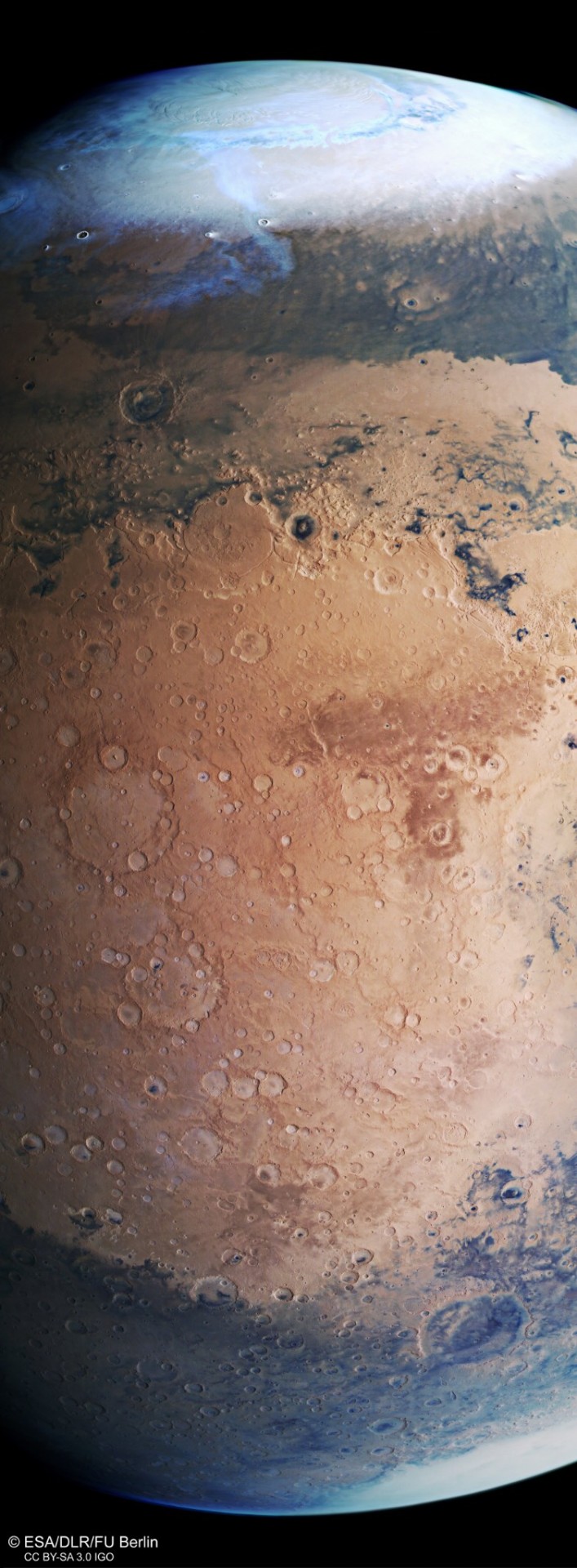
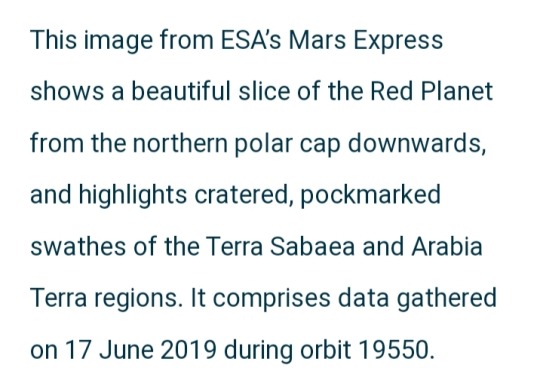


#Mars#Mars Express#European Space Agency#ESA#High Resolution Stereo Camera#red planet#planet#astronomy#space#Hellas Planitia#crater#space exploration#spacecraft
1 note
·
View note
Text
Monte Olimpo em Marte já foi cercado por água
Um novo estudo sugere que o Olympus Mons de Marte, o vulcão mais alto do sistema solar, já foi cercado por um oceano marciano que moldou a superfície do planeta.
Um novo estudo sugere que o Monte Olimpo de Marte, o vulcão mais alto do Sistema Solar, já foi banhado por um oceano marciano que desempenhou um papel importante nas marcas de referência na superfície do planeta.
O Monte Olimpo é uma montanha colossal que se eleva a cerca de 22 quilômetros acima da planície marciana, quase três vezes a altura do Monte Everest na Terra. O vulcão tem um diâmetro…

View On WordPress
#água#deslizamentos de terra#ESA#hemisfério norte de Marte#Lycus Sulci#Mars Express#Marte#Monte Everest#Monte Olimpo#Planeta#Planeta Vermelho#Sistema Solar#Telescópio#Vulcão#Yelwa
0 notes
Text
Mars Express encontró algo extraño en el polvo marciano
Wow
El Mars Express de la ESA ha revelado que Marte produce patrones de nubes sorprendentemente parecidos a los de la Tierra que recuerdan a los de las regiones tropicales de nuestro planeta.
La Tierra y Marte tienen atmósferas muy diferentes. La atmósfera seca y fría de Marte está compuesta casi en su totalidad por dióxido de carbono, mientras que la de la Tierra es rica en nitrógeno y oxígeno. Su…
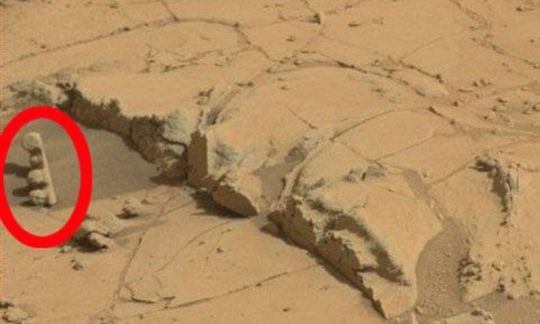
View On WordPress
0 notes
Text
20 yıllık Mars aracı hala Windows 98 kullanıyor! İşte sebebi
20 yıllık Mars aracı hala Windows 98 kullanıyor! İşte sebebi
Avrupa Uzay Ajansı (ESA) tarafından yaklaşık 20 yıl önce Mars’a gönderilen uzay aracı ile ilgili şaşırtan bir bilgi ortaya çıktı. Avrupa Uzay Ajansı’nın yayınladığı basın açıklaması, Mars Express araştırma görevindeki aracın hala Windows 98 tabanlı bir bilgisayar kullandığını ortaya koydu.
20 yaşındaki MARSIS neden Windows 98 çalıştırıyor?
Mars Express misyonu, ESA’nın Kızıl Gezegen için…

View On WordPress
0 notes
Text
Never-before-seen images of the largest canyon in the Solar System
Never-before-seen images of the largest canyon in the Solar System
You may also be interested
[EN VIDÉO] Mars: fly over the Korolev crater! Fly over the frozen crater Korolev, located near the polar ice cap of Mars, as if you were there!
Our neighbor the Red Planet is not called Mars by chance, it is of course its red color clearly visible on theeye naked from Earth, which earned him the name of the god of war in Rome (inherited from Babylon and Greece). So…
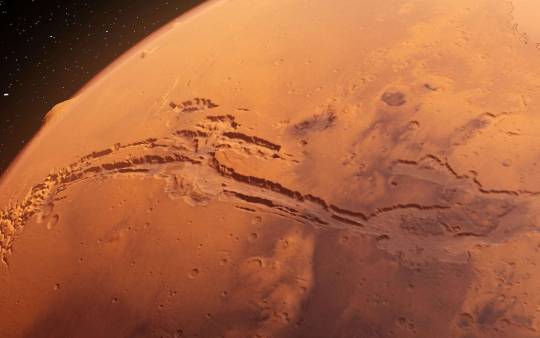
View On WordPress
#astronautics#canyon on mars#ESA#Fallen Chasma#geology of mars#Hebes Chasma#HRSc camera#landform of mars#march#marineris valleys#Mars Express#martian landscape#Mount Olympus#MRO#red planet#Tharsis Mountains#The planets#volcano on Mars
0 notes
Text
ESA's MARSIS to Get Major Software Upgrade 19 Years After Its Launch
ESA’s MARSIS to Get Major Software Upgrade 19 Years After Its Launch
The Mars Advanced Radar for Subsurface and Ionospheric Sounding (MARSIS) instrument on the European Space Agency’s (ESA) Mars Express spacecraft is set to get a major software upgrade that will boost its capabilities. The Mars Express was ESA’s first mission to Mars, launched on June 2, 2003 and it ran Windows 98. It has been equipped with the MARSIS instrument that had discovered signs of liquid…
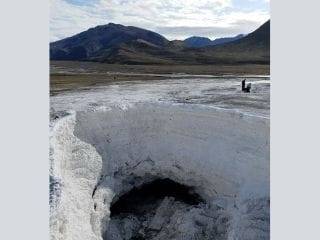
View On WordPress
0 notes
Text
This crater on Mars is 3 times the area of Greater London and its filled with ice almost 2 kilometers thick It's not CO₂ ice as is common on Mars, it's water ice. Welcome to Korolev crater, near the Martian north pole Taken from orbit by ESA’s Mars Express / DLR/FU Berlin

#planets#astronomy#space#astrophotography#universe#nasa#astro#galaxy#astronout#astro notes#galaxies#solar system
171 notes
·
View notes
Video
youtube
2024 February 26
Martian Moon Eclipses Martian Moon
Video Credit: ESA, DLR, FU Berlin, Mars Express; Processing & CC BY 2.0 License: Andrea Luck
Explanation: What if there were two moons in the sky -- and they eclipsed each other? This happens on Mars. The featured video shows a version of this unusual eclipse from space. Pictured are the two moons of Mars: the larger Phobos, which orbits closer to the red planet, and the smaller Deimos, which orbits further out. The sequence was captured last year by the ESA’s Mars Express, a robotic spacecraft that itself orbits Mars. A similar eclipse is visible from the Martian surface, although very rarely. From the surface, though, the closer moon Phobos would appear to pass in front of farther moon Deimos. Most oddly, both moons orbit Mars so close that they appear to move backwards when compared to Earth's Moon from Earth, both rising in west and setting in the east. Phobos, the closer moon, orbits so close and so fast that it passes nearly overhead about three times a day.
∞ Source: apod.nasa.gov/apod/ap240226.html
55 notes
·
View notes
Text
Windswept piles of dust, or layers of ice? ESA's Mars Express has revisited one of Mars's most mysterious features to clarify its composition. Its findings suggest layers of water ice stretching several kilometers below ground—the most water ever found in this part of the planet.
Over 15 years ago, Mars Express studied the Medusae Fossae Formation (MFF), revealing massive deposits up to 2.5 km deep. From these early observations, it was unclear what the deposits were made of—but new research now has an answer.
Continue Reading.
54 notes
·
View notes
Photo

Valles Marineris Perspective from Mars Express
Credits: G. Neukum, FU Berlin, et al., DLR, ESA
35 notes
·
View notes